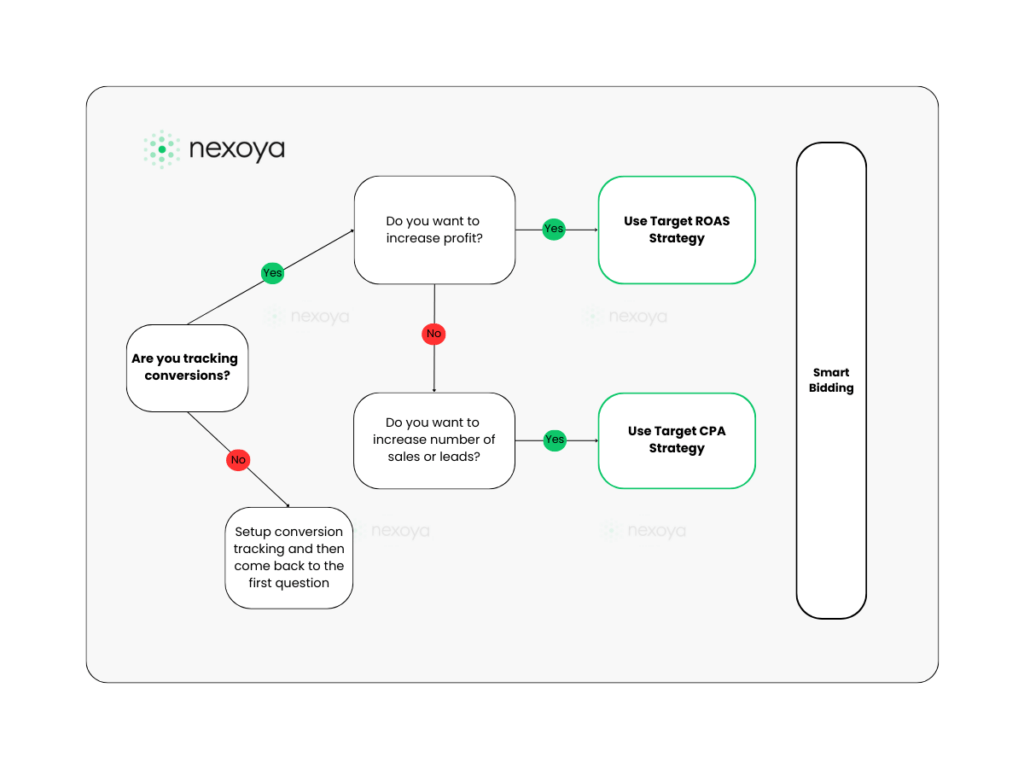In our last article, we discussed how to choose the right bidding strategy for your business and looked at automated bidding strategies for Google Search ads. Today we’ll take an even deeper dive into the topic and look into Smart Bidding and its two most commonly used strategies – Target ROAS (TROAS) and Target CPA (TCPA).
Table of Contents:
- What is Smart Bidding?
- Differences between Smart Bidding Strategies – TROAS and TCPA
- Things to Keep in Mind
- More Straightforward Application of Smart Bidding with Nexoya
So, First of All, What is Smart Bidding?
Smart Bidding is a set of automated bidding strategies that uses machine learning to optimize for conversions or conversion value on Google. Thanks to AI technologies these strategies allow you to adjust bids in real-time based on different signals like device, location, time, and user intent. To make it easier to understand, let’s look at an example. Let’s say Google determines that young women, when using their smartphones at night and in a specific location are most likely to convert or generate more revenue for your business. Consequently, Google will adjust the bid automatically for you to ensure these users are more likely to see the ad.
This saves time and effort and might help achieve better results. It can be a game-changer for advertisers looking to optimize their bids and maximize their return on investment (ROI). However, it’s important to note that Smart Bidding is not a one-size-fits-all solution. So before you start, make sure you understand your advertising goals, sales cycle, historical data, and budget. Otherwise, the Smart Bidding algorithm could end up overspending on ineffective ads, leading to poor ROI.
Get instant access to our
free library of resources
✔ Dozens of templates for data-driven marketeers
✔ Expert tips on how to improve your marketing
✔ Checklists and how-to guides for campaign optimization
✔ Best tools for AI in marketing
✔ Recorded webinars
Differences between Smart Bidding Strategies – TROAS and TCPA
As mentioned, Target ROAS and Target CPA are the most commonly used smart bidding strategies. However, to ensure the best outcome, it’s essential to understand the main differences and typical use cases. Let’s have a look at them!
Target ROAS (TROAS):
The objective of Target ROAS is to generate more revenue/profit for the business by achieving a specific return on ad spend.
How it works: Google predicts future conversions and associated values using your reported conversion values. It checks the historical data of your account to predict which clicks are more likely to generate more revenue and then adjusts bids accordingly.
Example: imagine you have an online store selling various homemade candles with different price points. Your business goal is 400% ROAS, meaning you get 4 dollars of revenue back for every dollar you spend. In this case, you could try the TROAS bidding strategy for your ads because you have associated specific values with each product that can be measured.
Target CPA (TCPA):
The objective of Target CPA is to generate more valuable conversions at a specific cost
How it works: This strategy automatically finds optimal bids to get the most conversions possible at your target CPA. It uses historical data to predict which clicks are more likely to convert and then adjusts bids accordingly. As a result, target CPA focuses on optimizing the cost per conversion rather than the overall conversion value.
Example: imagine you are an insurance provider whose business is focused on generating leads. You have particular budget constraints. Therefore, you may set a Target CPA to optimize your ad campaigns to generate more high-quality leads at a specific cost.

Things to Keep in Mind
- It’s important to note that these Smart Bidding strategies require sufficient data to work effectively, so it’s recommended to have at least 15-30 conversions or sales within the last 30 days before implementing Smart Bidding. For the Target ROAS, at least 50 conversions for optimal performance are preferred.
- You want to avoid putting handcuffs on Google’s algorithms by giving too narrow and specific keywords. This would likely slow down its learning process and stop you from reaching your goals. Instead, apply broad-match keywords.
- Refrain from acting drastically with changes on targets. If you achieved a ROAS of 250% in the past, don’t try to increase it suddenly to 400%. The same principle goes for CPA. Instead, try gradually increasing your performance objectives.
- Keep in mind that by setting up targets with smart bidding strategies, you are also limiting yourself, as it will only allow you to spend the planned budget if the targets are met. Solutions like Nexoya will enable you to solve this problem.
More Straightforward Application of Smart Bidding with Nexoya
Understanding and implementing Smart Bidding strategies correctly can be complex, but they remain crucial if you want to optimize your performance. AI-powered tools like Nexoya can help optimize cross-channel campaigns that use various bidding strategies using Predictive analytics. Thanks to machine learning algorithms, Nexoya analyzes your data, providing in-depth insights and recommendations on allocating your budget and adjusting your bidding strategy to achieve a higher return on ad spend (ROAS).
Nexoya provides target proposals and can automatically apply them, ensuring the best possible budget allocation across multiple campaigns.
Eager to learn more about Bidding strategies? Explore our cheat sheet for all the bidding strategies across various channels.